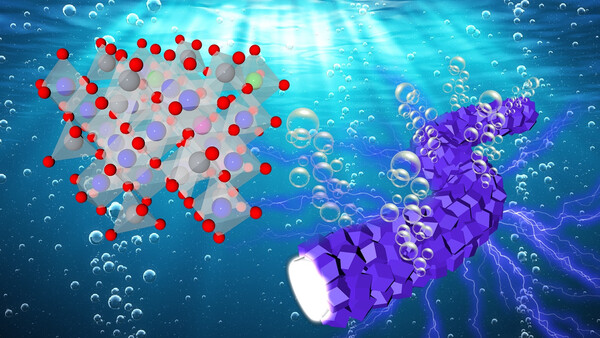[미국] 아르곤환경연구소, 물에서 환경 지속 가능한 수소 생산 돕는 새로운 저비용 촉매 개발
 미국 에너지부의 아르곤 국립 연구소(Argonne National Laboratory)가 이끄는 팀이 지구에 풍부한 원소들로 구성된 새로운 촉매를 개발했다고 밝혔다. 운송 및 산업 응용 분야에 사용할 수소를 저비용에 효율적으로 에너지 생산이 가능하도록 할 수 있다. 청정 수소는 배출된 오염 물질이 없는 차량을 추진할 수 있을 뿐만 아니라 산업 공정의 탈탄소에도 도움이 될 수 있다.
미국 에너지부의 아르곤 국립 연구소(Argonne National Laboratory)가 이끄는 팀이 지구에 풍부한 원소들로 구성된 새로운 촉매를 개발했다고 밝혔다. 운송 및 산업 응용 분야에 사용할 수소를 저비용에 효율적으로 에너지 생산이 가능하도록 할 수 있다. 청정 수소는 배출된 오염 물질이 없는 차량을 추진할 수 있을 뿐만 아니라 산업 공정의 탈탄소에도 도움이 될 수 있다.

물과 전기 반응하는 동안 섬유질의 빛에서 발생하는 중단 기포와 코발트계의 충격 구조.
이번 프로젝트는 DOE의 샌디아 국립연구소(Sandia National Laboratory)와 로렌스 버클리 국립연구소(Lawrence Berkeley National Laboratory, Ginner Inc.)의 협력을 통해 진행됐다.
양성자 교환막(PEM) 전해조는 수소 생산을 위한 신세대 기술을 나타낸다. 상온에서 높은 효율로 물을 수소와 산소로 분해할 수 있다. 감소된 에너지 수요는 태양열과 풍력과 같은 재생 가능한 간헐인 공급원을 사용하여 깨끗한 수소를 생산하는 데 이상적인 선택이 되게 한다.
이 전해조는 각 전극(양극 및 음극)에 대해 별도의 촉매를 사용하여 작동한다. 양극 촉매는 수소를 생성하는 반면 음극 촉매는 산소를 생성한다. 문제는 양극 촉매가 이리듐을 사용한다는 점인데, 현재 시장 가격은 온스당 5천 달러 정도다. 이리듐의 공급 부족과 높은 비용은 PEM 전기 분해기의 광범위한 채택에 주요 장벽이 된다. 새로운 촉매의 주요 성분은 이리듐보다 상당히 저렴한 코발트다.
전기 분해기와 연료 전지의 상용화를 위해 노력하고 있는 선도적인 연구 개발 회사인 지너(Giner Inc.)는 산업 운영 조건에서 PEM 전기 분해기 테스트 스테이션을 사용하여 새로운 촉매를 평가했다. 성능과 내구성이 경쟁사 촉매보다 월등히 뛰어나다.
이번 성과는 1960년대 미국 우주 프로그램의 "문 샷(Moon Shot)"을 모방한 DOE의 수소 에너지 어스샷(Earthshot) 계획에서 한 걸음 더 나아갔다는 데 있다. 앞으로의 목표는 10년 안에 녹색 수소 생산 비용을 킬로그램 당 1달러로 낮추는 것이다. 그 비용으로 녹색 수소를 생산하는 것은 국가 경제를 재편성할 수 있다. 적용 분야에는 전기 그리드, 제조, 운송 및 주거용 및 상업용 난방이 포함된다.
[원문보기]
New Low-cost Catalyst Helps Produce Environmentally Sustainable Hydrogen From Water
A team led by the U.S. Department of Energy’s (DOE) Argonne National Laboratory has developed a new catalyst composed of elements abundant in the Earth. It could make possible the low-cost and energy-efficient production of hydrogen for use in transportation and industrial applications. Clean hydrogen could not only propel vehicles with no emitted pollutants but also help decarbonize industrial processes.
Other contributors to the project include DOE’s Sandia National Laboratories and Lawrence Berkeley National Laboratory, as well as Giner Inc.
Proton exchange membrane (PEM) electrolyzers represent a new generation of technology for hydrogen production. They can split water into hydrogen and oxygen with high efficiency at near room temperature. The reduced energy demand makes them an ideal choice for producing clean hydrogen by using renewable but intermittent sources, such as solar and wind.
This electrolyzer runs with separate catalysts for each of its electrodes (cathode and anode). The cathode catalyst yields hydrogen, while the anode catalyst forms oxygen. A problem is that the anode catalyst uses iridium, which has a current market price of around $5,000 per ounce. The lack of supply and high cost of iridium pose a major barrier for widespread adoption of PEM electrolyzers. The main ingredient in the team’s new catalyst is cobalt, which is substantially cheaper than iridium.
Giner Inc., a leading research and development company working toward commercialization of electrolyzers and fuel cells, evaluated the new catalyst using its PEM electrolyzer test stations under industrial operating conditions. The performance and durability far exceeded that of competitors’ catalysts.
The team’s achievement is a step forward in DOE’s Hydrogen Energy Earthshot initiative, which mimics the U.S. space program’s “Moon Shot” of the 1960s. Its ambitious goal is to lower the cost for green hydrogen production to one dollar per kilogram in a decade. Production of green hydrogen at that cost could reshape the nation’s economy. Applications include the electric grid, manufacturing, transportation and residential and commercial heating.
[출처 = 아르곤국립연구소(Argonne National Labortory)(https://www.anl.gov/article/extracting-a-clean-fuel-from-water) / 2023년 5월 30일]




































